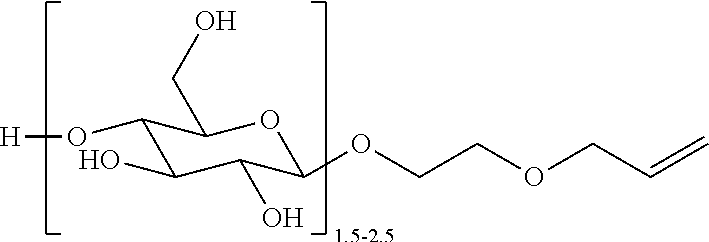Polyorganosiloxane gels having glycoside groups
- Summary
- Abstract
- Description
- Claims
- Application Information
AI Technical Summary
Benefits of technology
Problems solved by technology
Method used
Image
Examples
example 28
Hair Mask Conditioner
[0168]A hair mask conditioner was produced using example 14 according to the following method (parts hereinafter are understood to mean parts by weight):
[0169]To an initial charge of water are added 1.5 parts of hydroxyethyl cellulose while stirring. Subsequently, 1 part of PEG-40 Hydrogenated Castor Oil is dissolved and 2 parts of example 14 added. This mixture is heated up to 75° C. During the heating, 1.5 parts of Cetyl Alcohol, 3 parts of Stearyl Alcohol, 1 part of Stearamidopropyl Dimethylamine, 3 parts of Behentrimonium Chloride, 2 parts of Glycerin and 1 part of Simmondsia Chinensis (Jojoba) Seed Oil are added. The mixture is stirred until 75° C. is attained and the ingredients are in dissolved form. Then the mixture is cooled. At 40° C., 0.2 parts of Citric Acid, 1 part of Ethylhexyl Methoxycinnamate, 0.1 part of Vitis Vinifera (Grape) Seed Oil and 0.1 part of Panthenol are added. Subsequently, the mixture is preserved with 0.1 part of Methylchloroisothi...
example 29
Hair Balm
[0170]A hair balm was produced using example 14 according to the following method:
[0171]To an initial charge of 0.6 part of Aminomethyl Propanol are added 10 parts of BELSIL® P 1101. While stirring, 27.5 parts of water and 0.4 part of PEG-40 Hydrogenated Castor Oil are added. Subsequently, 2 parts of example 14 are added.
[0172]A second vessel was initially charged with 11 parts of water and 0.1 part of Disodium EDTA is dissolved while stirring. Then 3 parts of Glycerin and 0.5 parts of farnesol, linalool are added. This mixture is added to the mixture in the first vessel while stirring.
[0173]A third vessel is initially charged with 43.8 parts of water and 0.7 part of Acrylates / C10-30 Alkyl Acrylate Crosspolymer is dissolved. Then 0.1 part of Methylchloroisothiazolinone, Methylisothiazolinone and 0.3 part of perfume are added. This mixture is added to the first vessel while stirring.
TABLE 10Constituents of hair balmPhaseTrade nameINCI namePartsAAMP-95 1)Aminomethyl Propanol0...
example 30
Nourishing Night Cream
[0174]A nourishing night cream was produced using example 13 by the following method:
[0175]Phases A and B were weighed out separately and heated to 75° C. Phase A was added to phase B and homogenized with an Ultra Turrax T 25 basic at 15,000 revolutions per minute for 10 minutes.
[0176]The emulsion was brought to room temperature while stirring with a magnetic stirrer at 350 rpm. In the course of this, after the temperature went below 40° C., the substances of phase C were added and stirred in.
[0177]As the last component, example 13 was first stirred into the emulsion with a spatula. Thereafter, the mixture was homogenized again with the Ultra Turrax, 3 minutes at 11,000 revolutions per minute.
TABLE 11Constituents of nourishing night creamTrade namePhaseINCI(manufacturer / supplier)PartsAGlycerinGlycerol 100% anhydrous5.00(Merck KGaA)AAqua (DI Water)Water52.42ASodium ChlorideSodium chloride1.00(Merck KGaA)BDiethylhexyl CarbonateTegosoft DEC6.00(Evonik Goldschmidt ...
PUM
| Property | Measurement | Unit |
|---|---|---|
| molar ratio | aaaaa | aaaaa |
| molar ratio | aaaaa | aaaaa |
| total weight | aaaaa | aaaaa |
Abstract
Description
Claims
Application Information
 Login to View More
Login to View More - R&D
- Intellectual Property
- Life Sciences
- Materials
- Tech Scout
- Unparalleled Data Quality
- Higher Quality Content
- 60% Fewer Hallucinations
Browse by: Latest US Patents, China's latest patents, Technical Efficacy Thesaurus, Application Domain, Technology Topic, Popular Technical Reports.
© 2025 PatSnap. All rights reserved.Legal|Privacy policy|Modern Slavery Act Transparency Statement|Sitemap|About US| Contact US: help@patsnap.com

